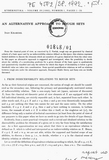Article
Full entry |
 PDF
(1.2 MB)
Feedback
PDF
(1.2 MB)
Feedback
 PDF
(1.2 MB)
Feedback
PDF
(1.2 MB)
Feedback
References:
[1] M. Davis: Computability and Unsolvability. McGraw-Hill, New York 1958. MR 0124208 | Zbl 0080.00902
[2] A. A. Fraenkel, Y. Bar-Hillel: Foundations of Set Theory. North-Holland, Amsterdam 1959 (Russian translation: Mir, Moscow 1966). MR 0101841
[3] P. R. Halmos: Measure Theory. D. van Nostrand, New York 1950 (Russian translation: Izd. Innostr. Lit., Moscow 1953). MR 0033869 | Zbl 0040.16802
[4] M. Kubat: More attention to the rough set theory. In: Aplikace umělé inteligence AI89, ÚISK Prague, 1989, pp. 361 - 368.
[5] T. S. Kuhn: The Structure of Scientific Revolutions. Oxford Univ. Press, Oxford 1980.
[6] K. Kuratowski, A. Mostowski: Teoria mnogošci (Set Theory). Second edition. PWN, Warsaw 1966.
[7] P. Maddy: Believing the axioms. J. Symbolic Logic 53 (1988), No. 2, pp. 481 - 511, No. 3, pp. 736 - 764. Zbl 0656.03034
[8] V. Novák: Fuzzy Sets and their Applications. Adam Hilger, Bristol - Philadelphia, SNTL, Prague 1989. MR 1019090
[9] E. Orlowska: Semantics of knowledge operators. Bull. Polish Acad. Sci. Math. 35 (1987), 5-6, 255 - 263. MR 0919210 | Zbl 0639.68106
[10] E. Orlowska: Algebraic approach to database constraints. Fund. Inform. 10 (1987), 1, 57 - 68. MR 0887573 | Zbl 0643.68159
[11] E. Orlowska: Representation of vague information. Inform. Systems 18 (1988), 2, 167 - 174. Zbl 0647.68081
[12] Z. Pawlak: Information systems - theoretical foundations. Inform. Systems 6 (1981), 2, 205 - 218. Zbl 0462.68078
[13] Z. Pawlak: Rough sets. Internat. J. Comput. Inform. Sci. 11 (1982), 3, 341 - 356. MR 0703291 | Zbl 0525.04005
[14] Z. Pawlak: Rough Sets and Fuzzy Sets. Institute of Computer Science, Polish Academy of Sciences, Report No. 540, Warsaw 1984. MR 0808468 | Zbl 0538.04004
[15] J. Pearl: Probabilistic Reasoning in Intelligent Systems - Networks of Plausible Inference. Morgan Kaufmann Publishers, Inc., San Mateo, Calif. 1988. MR 0965765
[16] G. Shafer: A Mathematical Theory of Evidence. Princeton Univ. Press, Princeton 1976. MR 0464340 | Zbl 0359.62002
[17] G. Shafer: Probability judgment in artificial intelligence and expert systems. Statist. Sci. 2 (1987), 1, 3 - 4. MR 0896256 | Zbl 0955.68506
[18] M. Wygralak: Some remarks on rough and fuzzy sets. Busefal 21 (1985), 1, 42 - 48.

